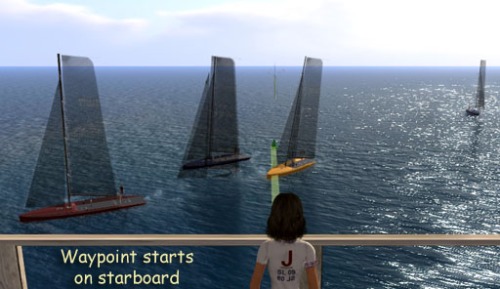The 2009 J-Classic Regatta Series got off to a wonderful start this past weekend, with a truly fantastic series of first round races.
Since the teams include a number of crewmembers who are racing for the first time, and since we have eight more events to go in the regatta series, I thought it might be a good idea to spend a few minutes talking about basic race topics that will probably come up in the rounds ahead. The J-Classic fleet is full of wonderful, racing-savvy sailors who already know most of what I’m going to say better than I do… so I’d ask them to please feel free to post their comments, fill in what I forgot, and add their ideas and opinions on these and any other topics.
I wanted to begin by talking about about Race Starts. In real life as well as in SL, getting a good start is often critical to a winning a race. The first boat that crosses the line on their intended course without fouling gains as a huge advantage, with open water and clean air. Since there are no other boats around to cramp their style, the first boat over the line can set its own course and run the race just as the crew practiced it. The lead boat is the ‘alpha dog’ at the head of the pack, and its a huge advantage.
So? How do you get a good start? Here’s one simple strategy from Real Life.
“If you win the start, you can win the race.”
When the countdown starts, all boats raise sail and begin to jockey for position and build up momentum.
The prestart is easily the most crowded part of a race, and the Right-Of-Way Rules become critically important.
They often determine who captures the lead.
Rule 10 is:
10. Starboard Rights: Starboard boats have Right-Of-Way over Port Tack Boats
Under Rule 10 most skippers choose to start a race by crossing the line on a Starboard tack, since any boat on Port will need to give way.
The image below from this morning demonstrates this well; the entire Waypont fleet crossed the line on a similar starboard course.
But if everyone is on a Starboard tack, you need another trick up your sleeve to get a startline advantage. Most sailors go with Rule 11:
11. Leeward Rights: Leeward boats have Right-of-Way over Windward Boats
All the crews are vying to cross the line at the same moment, when the countdown hits zero.
If you are the leeward boat during that countdown, all the others need to get out of your way. You not only get red carpet treatment; everyone else loses momentum trying to avoid you. It’s even better when you have several boats parallel and overlapped about to cross the line. If you’re the leeward boat, all you need to do is yell “LEEWARD!!!” or “UP UP UP.” That forces the boat adjacent to you to turn into the wind, and often causes a domino effect. All the other boats upwind of them suddenly are forced to turn as well, while you stay on course and wave “bye.”
So: The strategy you want is one that puts you on a starboard tack and positions you as the leeward boat as you hit the raceline a moment after it turns green.
There are two more nuances…
Most race lines are perpendicular to the wind, so it may not seem to make much difference which point of the line you cross. Well, take a look at Waypoint above… and pictures of any other expert race fleet. They are all starting from the end of the line at the windward buoy. That position gives them the longest first tack moving toward the windward mark. They all know the boat that makes the fewest tacks while maintaining momentum often leads at the Finish. Those gybes along the way aren’t free; you pay for them in time and momentum.
There is another thing about that windward raceline buoy, however.
Take a look at the two pictures below from NYC Sunday Big-Boats a few days ago. LDeWell Hawker was steaming in on a Starboard tack, aiming to slice the line at 00:00 sec on the far windward edge near the green buoy. Gemma Vuckovic was also ready, though… a few moments before the top picture, she suddenlycame about, expertly falling into a parallel and overlapped position, just leeward and a fraction of a second ahead of Hawk. The lower image below shows them crossing together, close enough to whisper sailing complements to each other.
If this race were “serious,” however, Hawk knows that Gemma might not be quite so polite! As I mentioned above, the leeward boat has ROW. Gemma could call “UP UP UP” and force Hawk to turn windward. Doing so would most probably slam him into that innocent little green buoy at the line’s end.
Hawk’s a pretty great sailor, and he sees this strategy too; Gemma made her point that night. Enough said!

Gemma and Hawk off to a good start.NYC Big-Boat Race AUG 30
(Note: the start buoys are not considered obstructions or race marks under the Rules. You can’t ask for “Room!” under Rule 19, and sorry… Rule 18 doesn’t apply either. So if Gemma pushes you into a racline buoy next week, dont complain (grin) — it’s your own fault!)
OK– A good, standard start then means: You do a Starboard tack, nose into the far Lee position, and point your bow at the Windward end of the line…
But just one more thing: After the Start, use your advantage to move into the Windward slot with respect to the rest of the fleet.You needed Leeward rights to control your start position while milling with the fleet in the countdown. Once you cross the line, however, your priorities change a bit; it’s Showtime. Now you need to stay Windward of the fleet. In that location you can shadow any pretentious competition that tries to creep up on you, and you can defend your lead. After all, on an upwind beat, the windward boat can always speed up by falling slightly off the wind. The attacking leeward boat isnt so lucky; it needs to point higher to pass and it will lose momentum in that process. Even worse, the leeward passing boat has to get by the lead boat’s shadow. It’s not a easy task (grin).
Some of you may wonder if skippers actually use these tactics effectively in SL…
Grin. Maybe not as often as they should! But in the 2007 Tako Cup semifinals and finals, a number of excellent real life and SL skippers paired off, and used the Start Rules to great effect. They were so good and so relentless dueling for leeward advantage that a set of optional pre-start rules were introduced into the competition to make prestarts fair. The Rule changes were exactlywhat happens in real life as well to deal with this situation and it was pretty humorous … and quite amazing… to see it happen in SL.
I know most sailors in SL and RL are pretty familiar with the strategy I discussed above. I also know it doesn’t apply in all cases, and a skipper being inventive and adaptive, using unconventional strategies in new situations is often important too.
However, as in chess, choosing an unconventional opening move can often prove pretty risky…
On Monday Aug 31, for example, we did a practice run on the Round Two — Fruit Islands Racecourse. A gaggle of great skippers showed up to limber their muscles and stretch their wings across the course as part of their J-Classic practice. If anyone was contemplating some unusual tactics or was interested in testing a novel start, the Monday race was a good place to try it.
As you can see in the figure below, Oh boy did they try it. Despite a crowded pack of very smart, experienced skippers that would likely reach the start line at the same time together, separated by mere inches …
Two boats in the fleet attempted Port starts.

Fruit Islands Big-Boat Race AUG 31
As you can see in the second image, The Port start boats came within angstroms of colliding with a wall of spar-and-canvas from the Starboard ROW boats.
Several of us gasped in horror and apprehension.
Of course, however, the fleet are all pretty wonderful; they have considerable adaptive resources and were able to steer away, side-stepping catastrophe. Once the collisions were avoided, everyone had a good laugh over the audacity of the Ports starts, and the fleet barely missed a beat while turning away to confront the real challenge: the J-Classic Fruit Islands course!
It was pretty funny to watch it on Monday play out… but let me tell you, I’m bring ear plugs for Saturday. A Port start like that on Staturday’s Round 2 race will evoke a chorus of protests that could cause inner ear damage!
____________________



















